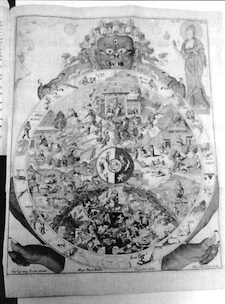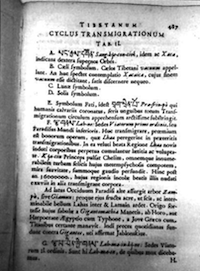Alphabetum Tibetanum: The Beginnings of Tibetology in the Western World
Antonio Agostino Giorgio
Editiones Voce: Cologne, 1995.
820 pp., $70.00 (cloth).

Alphabetum Tibetanum, a massive, 820-page work written in 1762 in late scholarly Latin, constitutes the first publication of its kind in the Western world: the first large-scale, encyclopedic attempt to understand Tibetan culture, language and religion from a Western perspective. Although the major section of the work is based on religious polemic, it retains value as a major link in the earliest chain of Tibetan studies in the West. The current edition, published in Italy, is a facsimile of the original book.
The entire work was a result of the Catholic Capuchin missionary work in Lhasa during the early to mid-eighteenth century. During this time, when a massive Chinese military and cultural presence from the Ching court was established in Tibet, the Capuchins had established a mission in Lhasa in 1707 and were studying with Tibetan lamas. When the Catholic missionaries left Tibet in 1745 (following a period during which missionary work was forbidden and no new missionaries were allowed into Tibet), that brief window of Western access to Tibet, and indeed in Lhasa itself, closed, and has never been reopened to the present day on the scale that they enjoyed. Alphabetum Tibetanum was intended to assist missionaries who would be going to Tibet.
Part One, the most extensive section, is—perhaps understandably—an elaborate argument attempting to demonstrate that Tibetan religion is derived from the Manichaean heresy, the belief that the spirit could be released through ascetic practices. In the midst of this presentation, features of Tibetan religion, hierarchy, ritual, history and geography are described in detail. For example, an engraving gives what appears to me to be an accurate floor plan of the inner sanctuary of the Jokhang Temple in Lhasa.
The engraving illustrated here, of the Tibetan Wheel of Life, was made from an original in the Museum of Cardinal Borgia in Velletri. As

far as I am aware, this would have been the first Tibetan work of art published in the Western world. The original has since disappeared. This same thanka was reproduced as an engraving in the 1791 Study of Indian Religion based on the holdings of the Borgia Museum, by Paulinus a Sanctae Bartholomaeo. A much clearer engraving, it was copied from the exemplar in the Borgia Museum, which in turn was made by a Tibetan artisan from a color original preserved in a Lhasa temple. The representation of the twelve interdependent causes and their effects are pictured out of sequence and in the wrong order around the circle, presumably either replicating the original in Lhasa, or indicating that the Tibetan artist who painted the Borgia Museum thanka was inept. The Europeanizing elements in this engraving are evident. The Tibetan typefaces were created by a Capuchin monk named Francesco Orazio della Pena di Billi, who lived in Tibet for twenty-five years during the early eighteenth century and studied under one of the most illustrious lamas of that time.
Alphabetum Tibetanum is important for the understanding of the history of Tibetology as well as for the understanding of Catholic missionary work in Buddhist Asia. And although its primary lasting value is bibliographic, there are vast amounts of possibly factual information about the life, language, architecture, customs, festivals, and religious hierarchy in Tibet during the period of the Catholic missionary presence there.
Thank you for subscribing to Tricycle! As a nonprofit, we depend on readers like you to keep Buddhist teachings and practices widely available.